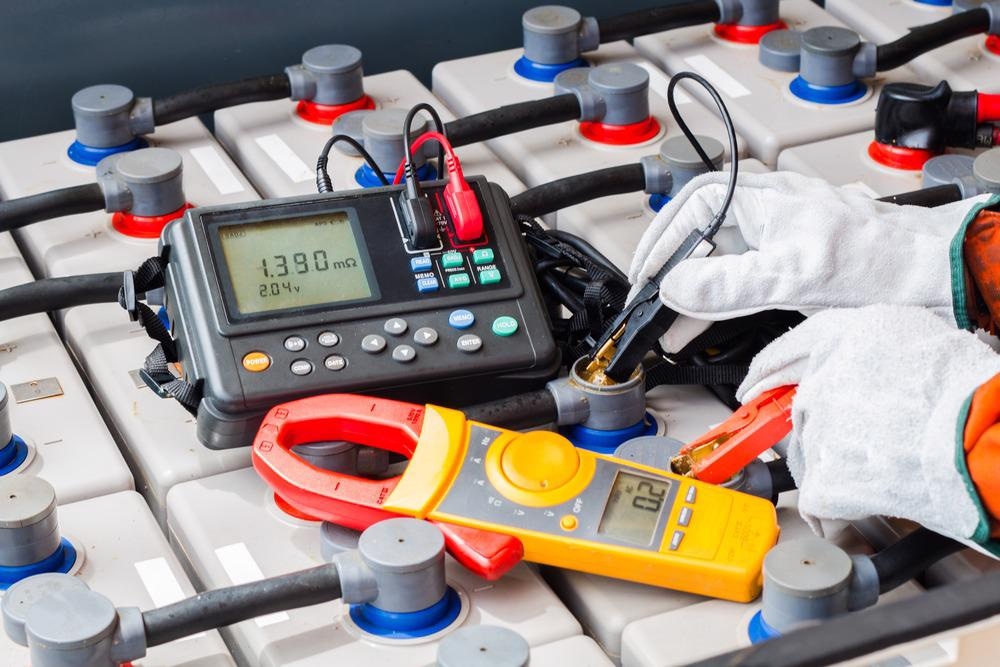For a long period, research on iron-air cells was put on hold due to intractable technological hurdles. However, in recent times, there has been a tremendous surge in study interest.

Image Credit: Xmentoys/Shutterstock.com
The power in an iron-air battery comes from the interaction of iron with oxygen. The steel oxidizes nearly exactly as it would during its corrosion phase within that procedure.
The oxygen necessary for the reaction may be taken from the ambient air, eliminating the requirement for the cell to store it. The high energetic densities with 1,200 Wh/kg produced by metal-air batteries are attributed to these component savings. Compared with the usual lithium-ion that has 600 Wh/kg, iron-oxygen batteries save more energy.
Iron-air batteries are relevant in this context. Because both ferrous and sodium - the building blocks of alkali solutions - are highly abundant, they have a high potential for growth. Simultaneously, the ferrous electrodes are extremely durable, capable of withstanding over 10,000 full cycles.
More on Green Batteries: Electrolytes for Lithium Batteries Obtained from Biomass
This equates to a life span of around 30 years. Iron-oxygen batteries are also resilient to overcharging, overcurrent, and partial discharge. A rechargeable iron-oxygen battery is able to supply 100 hours of energy at operating cost compared to traditional power stations and less than a tenth of the price of lithium-ion batteries.
Due to their exceptional energy density, evident environmental acceptability and extraordinary reversibility as opposed to other metal-air batteries, iron-air batteries have re-gained substantial research interest.
To fully leverage the energy density of steel to the best capability, the anode-to-overall cell material ratios should be as big as feasible, aiming for prospective iron-oxygen cell performance that is practically viable.
A steadily growing quantity of electrochemical oxidation carbonyl metal particles may serve as an alternative source of activated metallic surface for a sharply increased discharge rate during creation, which is especially important for thick electrodes instead of thin electrodes.
Additionally, microstructural alterations in the conductor are produced by hydrogen evolution throughout the initial formation. This varies by the state of the creation of porosity carbonyl ferrous-anodes; the mechanism implies the existence of an active layer on the exterior, and inactive because quasi on the interior of porous carbonyl anodes.

Image Credit: GreenTech/Shutterstock.com
Because of its low price, easiness of oxidation, numerous oxidation states, and its capability to be cathodic electrodeposited from an electrolyte solution, ferrous is an appealing element for a battery. The iron-air battery can be thought of as a replacement for iron-nickel with alkaline cells.
The major benefit is that no iron dendrites develop throughout the charging mode. Either way, significant hydrogen change occurs. Additional issues raised by NASA, who conducted the first research of iron-air batteries, include self-discharge, the possibility of damaging iron oxidation processes, and water loss.
A laminated iron electrode with a rectangular area of 100 cm2 was found to have long-term performances and adequate features. Researchers estimated that the batteries could be produced in a 400 cm2 electrode area module with a specific capacity of 140 W h kg-1 capable of 1000 cycles of US$30 (kg h)-1.
Due to recent advancements in nanomaterials and the potential of utilizing efficient nanostructured electrode catalysts to get a better energy density via greater surface size Fe nanoparticles, the iron-air battery technology has advanced in recent years.
Additional reasons include the low availability and price of iron, as well as the abundance of oxygen in the atmosphere.
In a planar parallel arrangement, ferrous–oxygen batteries typically have two air-breathing electrodes with one metal electrode inside. During the cycles of charge-discharge, the oxygen ions in the regenerative iron-air cell are intended to achieve both advancement and elimination of oxygen.
One of the obstacles to the implementation of effective metal-air cells is the lack of a counter electrode capable of withstanding large positive potentials throughout oxygen advancement.
Iron-air batteries have differences to other metal-air batteries because the oxidation reaction within iron-air batteries requires solid-phase evolutions.
The ferrous electrode does not quite form dendrites all through plating, but the structure and quantity of the electrode could adjust even during charging and discharging processes due to the incorporation of the voluminous, non-soluble materials Fe(OH)2 and Fe3O4 that have higher viscosity from Fe.
Components of the electrode might become inactive as a result of an unbalanced voltage and current transmission during the dissolution and plating cycles.
The best way to improve iron-air battery utilization is to create more parts of solid electrode available to the electrolytes by increasing the surface of the electrode with nano-sized ferrous particles. Some recent research has looked at nanomaterial iron electrodes and found that they had higher charge capacities than typical Fe3O4 powdered electrodes.
The electrodes are all well made to make the greatest use of nanoparticulate iron as the active components and bifunctional oxygen catalyst. To get the best result for the nanoparticle iron material, the iron's surface area must be in contact with the electrolyte with the biggest area possible.
References and Further Reading
Kerracher, R., et al. (2014) A Review of the Iron–Air Secondary Battery for Energy Storage. Weinheim: Wiley-VCH Verlag GmbH & Co. KGaA. DOI: 10.1002/cplu.201402238
Narayan, S. (2012). Materials challenges and technical approaches for realizing inexpensive and robust iron–air batteries. Retrieved from: https://www.sciencedirect.com/science/article/pii/S0167273811005820
Clifford, C. (2021). CLEAN ENERGY Stealthy battery company backed by Bill Gates, Jeff Bezos has a lot to prove. Retrieved from: https://www.cnbc.com/2021/08/25/form-energy-raises-240-million-on-iron-air-battery-promise.html
Disclaimer: The views expressed here are those of the author expressed in their private capacity and do not necessarily represent the views of AZoM.com Limited T/A AZoNetwork the owner and operator of this website. This disclaimer forms part of the Terms and conditions of use of this website.